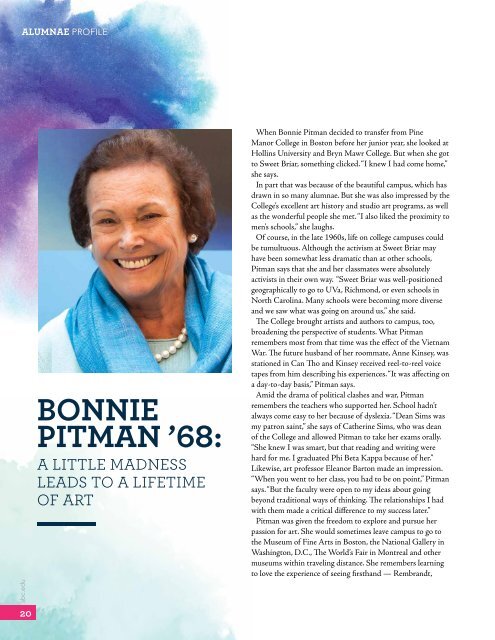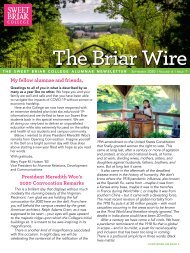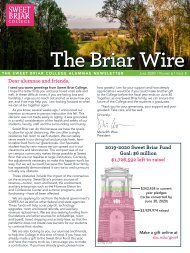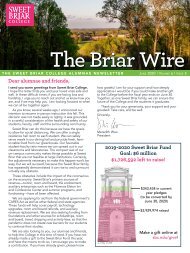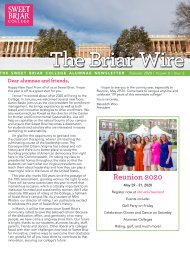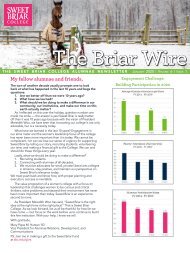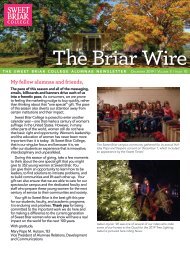Sweet Briar College Magazine - Spring 2018
Create successful ePaper yourself
Turn your PDF publications into a flip-book with our unique Google optimized e-Paper software.
ALUMNAE PROFILE<br />
BONNIE<br />
PITMAN ’68:<br />
A LITTLE MADNESS<br />
LEADS TO A LIFETIME<br />
OF ART<br />
When Bonnie Pitman decided to transfer from Pine<br />
Manor <strong>College</strong> in Boston before her junior year, she looked at<br />
Hollins University and Bryn Mawr <strong>College</strong>. But when she got<br />
to <strong>Sweet</strong> <strong>Briar</strong>, something clicked. “I knew I had come home,”<br />
she says.<br />
In part that was because of the beautiful campus, which has<br />
drawn in so many alumnae. But she was also impressed by the<br />
<strong>College</strong>’s excellent art history and studio art programs, as well<br />
as the wonderful people she met. “I also liked the proximity to<br />
men’s schools,” she laughs.<br />
Of course, in the late 1960s, life on college campuses could<br />
be tumultuous. Although the activism at <strong>Sweet</strong> <strong>Briar</strong> may<br />
have been somewhat less dramatic than at other schools,<br />
Pitman says that she and her classmates were absolutely<br />
activists in their own way. “<strong>Sweet</strong> <strong>Briar</strong> was well-positioned<br />
geographically to go to UVa, Richmond, or even schools in<br />
North Carolina. Many schools were becoming more diverse<br />
and we saw what was going on around us,” she said.<br />
The <strong>College</strong> brought artists and authors to campus, too,<br />
broadening the perspective of students. What Pitman<br />
remembers most from that time was the effect of the Vietnam<br />
War. The future husband of her roommate, Anne Kinsey, was<br />
stationed in Can Tho and Kinsey received reel-to-reel voice<br />
tapes from him describing his experiences. “It was affecting on<br />
a day-to-day basis,” Pitman says.<br />
Amid the drama of political clashes and war, Pitman<br />
remembers the teachers who supported her. School hadn’t<br />
always come easy to her because of dyslexia. “Dean Sims was<br />
my patron saint,” she says of Catherine Sims, who was dean<br />
of the <strong>College</strong> and allowed Pitman to take her exams orally.<br />
“She knew I was smart, but that reading and writing were<br />
hard for me. I graduated Phi Beta Kappa because of her.”<br />
Likewise, art professor Eleanor Barton made an impression.<br />
“When you went to her class, you had to be on point,” Pitman<br />
says. “But the faculty were open to my ideas about going<br />
beyond traditional ways of thinking. The relationships I had<br />
with them made a critical difference to my success later.”<br />
Pitman was given the freedom to explore and pursue her<br />
passion for art. She would sometimes leave campus to go to<br />
the Museum of Fine Arts in Boston, the National Gallery in<br />
Washington, D.C., The World’s Fair in Montreal and other<br />
museums within traveling distance. She remembers learning<br />
to love the experience of seeing firsthand — Rembrandt,<br />
sbc.edu<br />
20


